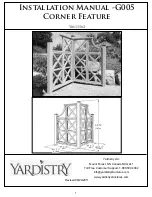
033-9900 User Manual Q6 (Advanced 6 year old) Rev. M
©2016 Humanetics Innovative Solutions Inc.
©
Page 82 of 96
3.
Attach the head-spine system to the part 572 pendulum. The side of the
head form should point in the direction of motion of the pendulum (see
4.
Lift the pendulum up to its pre-test height and check that the head form is in
the correct initial position.
5.
Install the potentiometers to the mounting interface and the on the head
form central block. Mount the balance mass for the potentiometer on the
other side of the central block. This ensures that the inertial properties of the
head are symmetrical in the impact direction.
6.
Insert the rod connecting the axes of the potentiometers and tighten the
screw on the bottom-most axis to secure the rod to the potentiometer. The
other end of the rod should be able to slide freely through the upper most
transducer axis. The rod must be protruding from both sides of the
transducers axes equal length.
7.
The minimum time interval to observe between tests on the lumbar spine is 30
minutes.
Figure 32.
Q6 lumbar spine certification test set-up for lateral test















































